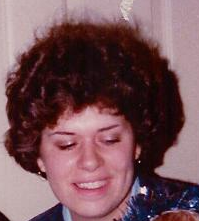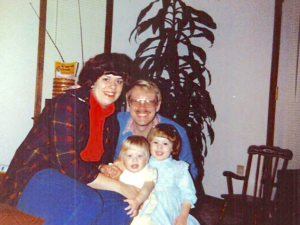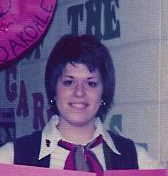
Life is an endless struggle full of frustrations and challenges, but eventually you find a hair stylist you like. ~Author Unknown
It’s hard to understand why none of us—not my brother, dad, or I—can remember her name. She was part of our family for probably a decade. She was quite visible in our home, and she went everywhere with my mom three days a week.
And yet we cannot remember the name my mother gave her wig.
I think it was expensive, this human hair wig that was dyed the same red as my mother’s was. Mom’s hairdresser styled it to look exactly like Mom’s hair looked on Friday afternoon after she had had her wash and set: a helmet of hair, with a smooth crust overlaying a nest of ratted tresses. A comma of curl on each side instead of bangs. Like a red-headed Lady Bird Johnson.
The wig (shall we call her Betty?) perched on a Styrofoam head on my parents’ dresser most of the week, waiting to be called into service when my mother’s hair had wilted. The substitution was so shrewd, so seamless, that nobody, except her kids and husband, was the wiser. Even when I look at pictures of my Mom from the sixties, I can’t tell if she’s sporting her own hair or Betty.

What do you think? Mom’s hair or Betty’s?
Those were the sixties when women of a certain age and social stratum got their hair done once a week. On Fridays, Mom and I worked together to clean up her first-grade classroom so we could scoot out in time for her weekly transformation at Hereford’s Beauty Salon in Brentwood.
Mrs. Hereford was a plump woman with a platinum beehive I found intriguing and enviable. Mr. Hereford was also chubby, but he always looked so smart in his starched white uniform jacket. He had a shiny, pink, mustachioed face and twinkly eyes. He smelled delicious, not at all like permanent solution or Aqua Net, more like Lifebuoy Soap. His blond hair had an impossibly precise side part. (It now occurs to me that Mr. H. may have had his own Betty.)
I loved accompanying Mom to the salon, partly because Mr. Hereford was quite taken with me. He called me “Guess What” because that is how I launched my monologues about all the fascinating things happening in my Whitaker Elementary School life. And I was mesmerized by the the renovation of so many stringy heads of hair. I was being inculcated with societal standards of female beauty. I thumbed through hairstyle magazines and looked forward to the day when I could be made beautiful.
I was especially fascinated by permanents, which proceeded through predictable, heinous steps: shampoo; sectioning and wrapping with end papers; rolling on rods; tucking strips of cotton under rods; applying stinky solution; rinsing and blotting; neutralizing; rinsing and blotting; removing rods and more rinsing and blotting; styling.
Notice that there was no shampooing after the perm — you couldn’t wash your hair for three days or the perm wouldn’t “take.” (Permanents were the first pregnancy tests; it was said they wouldn’t “take” if you were pregnant.)
Even after a shampoo, the noxious fumes assaulted you every time you rotated your head on your pillow. I once had a hair dresser who rinsed my hair with tomato juice after the perm was finished to diffuse the smell, a trick she used if her dog tangled with a skunk. My husband would invite that dog back in the house before post-perm me.
Mom’s hairdo created at Hereford’s required diligent maintenance. When Mom’s scalp, under her own hair or Betty’s, got itchy, she didn’t dare scratch it; instead she’d drill down through the morass with a knitting needle and go at it.
Mom fashioned a toilet paper turban, anchored with big silver clips, around her helmet each night. Betty looked on with patience, knowing my mother’s fine hair could only hold this height for so long. By Wednesday, Betty was pressed into service.
My dad, like most dads of this era, accepted the time and expense Mom’s hair care required. I think he viewed it as a woman’s chore, like cooking, cleaning, washing, and parenting.
I only have a faint idea of my father and brother’s hair regimens. I know it was Dad’s job to take Steve to the barbershop where, for quite some time, his hair was cut in a flat top, which required just a little goop in the front to make his hair stand up. My dad was the only one in the family with a great head of hair, thick and wavy and compliant, and I can’t say I remember him even having to comb it.
I wish I could remember when my mother ended it all—the weekly appointments, the toilet paper turban, the hair dye, and Betty. When was that hellish year when she let her hair grow grey? The roots grew in silver, and the red hair dye faded to pink. It was disconcerting watching this meticulously coiffed woman grow striped and pastel.

Silver, permed hair a month before she died
Until her dying day—really, almost to her last day—Mom got wash-and-wear perms from Maleva, a magician beautician who gave a permanent that neither smelled nor frizzed.
When I was in my teens, I took a ten-year hiatus from perms. I curled my own hair, using brush rollers because they created a smooth, swooping flip. The plastic curlers with caps made ridges and pleats, and Spoolies and foam rollers produced sausage curls.

A perfect flip
I think it was in my Sophomore year, 1967, when I started rolling my hair on orange juice cans and toilet paper rolls, as was all the rage. I even ironed it. Since my hair’s default setting was poker straight, it seems strange that I resorted to such methods, but I guess I wanted to look like all the other girls at slumber parties.
My bangs were a trial, though. I wanted them long, covering my eyebrows, which drove my mother crazy. Even my brother weighed in, calling me “turtle”(“Stop turtling,” he said) because I hunched my shoulders to look shorter, then looked up from under my bangs.
Keeping those bangs at the exactly right length required vigilance, which I had, and skill, which I didn’t. I learned pretty quickly that bangs-cutting was not DIY. On Friday’s I sometimes walked down from Finneytown High School to Hereford’s and begged my mom’s beautician to cut my bangs (“Just a trim!”) for a price that ranged, I think, from fifty cents to a buck.

The color indicated the holding power of the gel.
That curtain of bangs had to be absolutely straight, not puffy or bendy or slanty, which required a nightly application of Dippity-Do setting gel (I eschewed the stale beer of my youth) and a few pieces of scotch tape. In the morning, I pulled off the tape (resulting in less hair and less skin and the tell-tale tape marks). When I combed through the bangs, flecks of Dippity Do dandruff rained down on my face.
 In my Junior year that I became a born-again coiffeuse. Hot rollers were invented! No more curler-cursed nights. I could go swimming in the deep end in the afternoon and be ready for a date at night. These baked curls had staying power and enabled me, just four years later, to look good at my reception without wearing curlers in my wedding.
In my Junior year that I became a born-again coiffeuse. Hot rollers were invented! No more curler-cursed nights. I could go swimming in the deep end in the afternoon and be ready for a date at night. These baked curls had staying power and enabled me, just four years later, to look good at my reception without wearing curlers in my wedding.
 By my Senior year I had long, thick hair which I usually wore down, in low pigtails, or a side ponytail. I had the usual adolescent saturation of oil in my system, so I had to wash my hair frequently. This was difficult because we didn’t have blow dryers yet, just the big hood dryers or the kind that had a long hose connected to a bouffant hair cap. In either case, drying your hair was a long process and there were always sections that remained damp.
By my Senior year I had long, thick hair which I usually wore down, in low pigtails, or a side ponytail. I had the usual adolescent saturation of oil in my system, so I had to wash my hair frequently. This was difficult because we didn’t have blow dryers yet, just the big hood dryers or the kind that had a long hose connected to a bouffant hair cap. In either case, drying your hair was a long process and there were always sections that remained damp.
There were two solutions. I could use dry shampoo which came in an aerosol can or a dusting dispenser. I don’t know what was in it, but it was a devil to brush out. I ended up with a gray film at my scalp unless I brushed and brushed and brushed. Of course the brushing activated those oil glands, which landed me back where I started.
The other option was to wash just a portion of my hair, usually the oil-slicked crown and bangs, in the kitchen sink. The trick was to apply just a tiny dab of shampoo and rinse with the spray attachment. In theory, this should have freshened the hair, but I usually ended up with a matted, dull circle on the top of my hair where I wasn’t able to rinse to squeaky cleanness.
My hair was almost down to my waist when I got married, but within a year, I had it cut in a shag. My girlfriend highlighted it, pulling strings of hair through a perforated cap. Perhaps this should have been done by a professional. Sigh.


The Tennille
From age 25 to 45 my hair was mostly permed. There was a predictable cycle: frizzy, tight, rebellious curls the first month; manageable body the second month; fading glory the third month. I took breaks for the Toni Tennille look, a barber’s razor cuts, and limp bob.
A friend of mine, I’ll call her Jill, had very curly hair, which she straightened chemically and mechanically. She had it professionally colored in a fetching palette of warm browns. Her bathroom counter was evidence of the effort required to achieve that stunning

I tried to grow my hair out one last time in my forties. My hairdresser was thrilled when I decided to chop it off. I saved the hair, knowing it would be the last time it would be long.
coiffure: blow dryer; straightening iron; relaxing creams; lacquer spays, and a whole family of round brushes—Mama, Papa, and Baby Bear.
Unfortunately, Jill had to undergo cancer treatment, and she lost all of her hair. She is now cancer-free, praise be, and her hair has grown back. We recently met for lunch, and I was shocked when Jill said, “You know, being bald did not suck.”
It was through crisis that Jill learned the burden of hair, but most women eventually realize that they just haven’t got time for the pain.
My mom figured that out and embraced her natural hair color. Betty moved on, to where I don’t know. Goodwill? A cancer clinic? Knowing my mom, who sewed two halves of panty hose together when the other halves had runs, I imagine Betty’s hair was woven into a rug or knitted into mittens or cross-stitched into cushions.
My hair is still brown, and I guess you know why, but I’ve stopped trying to curl it into submission. No permanents, no curlers, no Dippity Do, no curling irons. My hair has looked pretty much the same for two decades, no matter who cuts it and for how much. It’s as unchangeable as my eyes, as sensible as my crepe-soled boots.
And Guess What? I have embraced my straight!

With daughter Stacey, who inherited her parents’ straight hair genes. This picture was taken at her surprise wedding.
Copyright © 2016 Sandy Lingo, All Rights Reserved





Loved all those pictures of you through the years and all the hairstyles. I remember the empty toilet paper rolls to curl. Women have such a love/hate relationship with their hair. Nice walk down memory lane.
Sandy,
You must have had a spy following me.You mentioned every style, product & method I used, except “Betty” , but my aunt did. . And in the correct sequence. Enjoyed the article.
Vickie Greco
Thanks for reading and responding, Vickie. I didn’t know you were a reader. Hope you are well.
It means so much to me that you are a faithful reader. It’s time for you to launch a blog!
We called her Aunt Ethel, but she was really some cousin of our Dad’s. After my Grandma’s funeral our “Aunt” came to our house and announced she knew how to cut hair the “curly way!” I fell for it, for I had hair so straight, perms could only tame. I was in the eighth grade then. She snipped so well I ended up with a Pixie cut with spikey twigs at my crown. They were not in style.
Oh, yes. I had a pixie, too–sound cuter and spunkier than it was. Those spikes are all the rage, now! Thanks for reading and responding.
You are always so right on. Thanks for sharing your awesome talent.
Boy, this brought back memories. I’m glad we don’t have time for the pain anymore. I laughed at Betty, especially your call back to her in the final paragraph. Boy, Sandy, you really do have a “knack.”;)
Ha! You have the knack, too.
Your detailed memories are so striking! For some reason, I completely missed that care-about-my-hair gene. I DO color it (obviously), but cannot even be bothered to blow-dry. Perhaps because my mother has always been rather low maintenance. Your memories are so funny, though!
I had a conversation with some girlfriends who are about my age, and we debated about when you should stop coloring your hair. When does it look ridiculous to have non-gray hair. I think in my fifties I thought I would have stopped the madness by now, but now I’m thinking, “Hmmm, seventy? eighty?” Thanks, as always, for reading and responding.
This was, as always, such fun to read, Sandy! You made me remember my “Farrah Fawcett” in high school and my “Dorothy Hammill” in college. When I was short on cash, I’d be a hair model for master stylists teaching brave new looks at hair conventions. Oy vey, those were some weird cuts! The worst one was my hair shaved on the right side of my head, with the remaining hair draped over my left eye. It was free, though!
OUCH!!! That’s me you’re describing, not your mom–except I never had a “Betty”–I was just flat for half the week. In fact, that’s partly me today. Weekly to the hairshop (mostly social occasion), scheduled perms and colors. Now when do you stop color–major decision. I say to my hair dresser “I’m going to go gray”, she helpfully responds “you’d immediately look ten years older” (since I’m 85 would that really make a great difference?), and I say “but, Beth, I don’t want to look like Lucille Ball during my last few days”,etc. It goes on and on without a decision. However, you may look forward to one day seeing me have that faded red, growing out gray look with a resigned look on my face to add flavor to the picture. Love you, Sandy
I love your stories, they always make me laugh and remember earlier times. My 89 year old Mother still has her hair “done” weekly. She just started 2 years ago letting it go “natural,” by not getting it dyed. It is now gray.
I’m glad I don’t sleep in rollers anymore — time to just let my hair be!!
Well……I finally got a chance to read your “Hair Care” blog!! You surely took me down memory lane……born in 1934, a girl’s hair was her “pride and joy!” Mothers spent endless time making sure that every curl was perfect…..though your blog’s time frame was much later, seems like girl’s hair and mother’s pride were no different.
Can you imagine what I went through when I had my hair cut off when I went to the convent?
Your writing is just “so much you!”
I am venturing writing….Why I left the convent. Hope I have the time and patience to finish. See you soon!
Thanks, Sandy. My straight hair story is similar to yours. It all seems so crazy at our present perspective. The cost of things we do for acceptance is a high price.